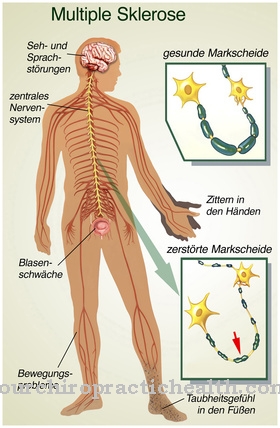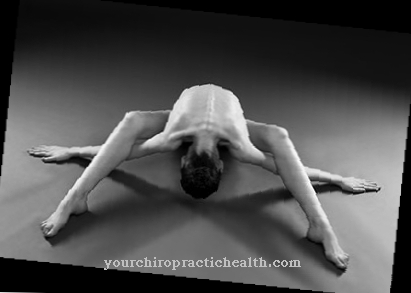The function of the anterior cruciate ligament is to stabilize the knee joint. It supports the rotary movements and the movement forward. Is this anterior cruciate ligament tornso the knee becomes unstable. Furthermore, consequential damage to the cartilage and menisci can occur.
What is an anterior cruciate ligament tear?
The effects of force can tear the cruciate ligament. It can be torn or completely torn. An anterior cruciate ligament tear occurs separately or is part of a larger knee injury.
Due to the crack, the knee is painfully swollen and its mobility is restricted. A feeling of instability and insecurity develops. The damaged cruciate ligament can lead to buckling events. Typically, the thigh and lower leg then shift against each other in an uncontrolled manner.
For some sufferers, the complaints only arise later, with permanent stress. Typically, the anterior cruciate ligament tear is often a sports injury. Exercise-intensive sports with many changes of direction can lead to a cruciate ligament rupture.
causes
The most common cause of an anterior cruciate ligament tear is extreme twisting trauma to the knee joint. This rotation in the joint with the lower leg stationary can cause several injuries to the knee.
In addition to the anterior cruciate ligament tear, damage to the collateral ligaments and other accompanying injuries to cartilage and menisci can occur. An anterior cruciate ligament tear always arises from an unusual overload and force on the knee joint. It was then stretched, bent, or twisted extraordinarily. An anterior cruciate ligament tear does not need any external influences. It can arise when the thighbone is forcibly overstretched.
Since very strong forces are necessary, previous damage can often play a role. The cruciate ligament may have been torn for a long time or cartilage may only be present in a degenerate form. Even a blow from the front can tear the anterior cruciate ligament. Football, skiing or martial arts are known to cause such injuries.
The "unhappy triad", an unfortunate combination of three types of injuries, also often occurs. Then, in addition to the anterior cruciate ligament, the inner collateral ligament and inner meniscus of the knee are also affected.
Symptoms, ailments & signs
An anterior rupture of the cruciate ligament is usually associated with considerable and long-lasting pain that persists even when the patient is at rest. In most cases, affected people can diagnose a cruciate ligament rupture themselves, since normal movement is no longer possible. Even the smallest movements cause great pain, so a visit to the doctor should not be postponed.
An existing cruciate ligament tear can only be restored with appropriate treatment and care. In many cases, surgery is even possible to ensure full and timely recovery. However, if you forego a visit to the doctor at this point, you have to expect a much more difficult course of the disease.
Under certain circumstances, permanent consequential damage can occur that cannot be remedied afterwards. In many cases there is severe swelling around the affected knee. These swellings can be perceived with the human eye without any problems.
When such a swelling occurs at the latest, an appropriate doctor should be consulted immediately. So the following applies: An anterior cruciate ligament rupture must always be treated by a doctor, medication or even in an inpatient setting. Otherwise there will be significant complications that cannot be resolved so quickly.
Diagnosis & course

A thorough clinical examination is very important for the exact diagnosis of an anterior cruciate ligament tear. A skilled doctor shouldn't just find the crack. Furthermore, the degree of instability is also very important.
An initial suspected diagnosis can be made with movement tests. However, the examination is more difficult because the knee joint often cannot be fully moved in an anterior cruciate ligament tear. The doctor depends on the patient describing the accident as precisely as possible. To get a more accurate picture, the doctor can puncture the knee joint.
To do this, he pricks the bent knee with a needle. The withdrawn liquid is then carefully examined. It is determined whether there are any indications of a ligament injury. Magnetic resonance imaging (MRI) provides certainty as to whether it really is an anterior cruciate ligament tear. It makes the anterior cruciate ligament visible and also reveals accompanying injuries.
The course of the disease is influenced by the age of the patient, the physical activity and the time of diagnosis or the start of the appropriate therapy. If the anterior cruciate ligament tear is consistently treated conservatively or surgically, there are good prospects of regaining full functionality. However, the leg muscles must be trained well over the long term.
Complications
If an anterior cruciate ligament tear is treated promptly, there are usually no major complications. However, with inadequate physical therapy and in elderly patients, a rupture can lead to premature joint wear. Osteoarthritis results in chronic pain, restricted mobility and other complications.
Problems can also arise during cruciate ligament surgery. In some cases, for example, bleeding, joint infections, thrombosis or injuries to the nerves, muscles or vessels occur. Postoperative complications cannot be ruled out either. Occasionally, after the cruciate ligament operation, movement restrictions or loosening of the graft occur.
In individual cases, meniscus damage or a fracture of the kneecap occur. Permanent instability is only retained in exceptional cases. There are always certain risks and side effects associated with taking pain medication.
In addition to typical symptoms such as headaches or skin irritations, an allergic reaction to the drug can rarely occur. If the drug is taken over a longer period of time, the internal organs, especially the kidneys, liver and heart, are increasingly stressed. Sometimes addictive behavior develops or the patient experiences withdrawal symptoms after the withdrawal.
When should you go to the doctor?
A doctor should be consulted if health irregularities occur after a turning movement, an accident or a force on the knee. If there are complaints in the knee area after excessive strain, it is also advisable to clarify the complaints. A doctor is not required if the symptoms are relieved within a few minutes or within half an hour. In these cases, adequate relief and rest should take place.If symptoms are free after a short period of time, there is no further need for action.
However, if the knee can no longer be loaded as usual despite sufficient rest, swelling develops or the joint movement can no longer be carried out as usual, a medical consultation is necessary. Movement irregularities or the inability to move should be investigated and treated. Pain, discoloration of the skin and a feeling of discomfort when performing only small movements indicate a problem with the joint. A doctor must be consulted to clarify the extent. If the appearance of the foot is already associated with discomfort, the person affected needs medical care. The symptoms are to be understood as warning signals from the organism. To avoid further complications, no further stress should be placed on the body.
Treatment & Therapy
The first therapeutic measure in the event of an anterior cruciate ligament rupture is to stabilize the joint. Immediately after the accident, the leg must be protected and raised. Furthermore, cooling makes sense and applying a pressure bandage. For the pain, a doctor can prescribe various pain relievers and anti-inflammatory drugs or even inject them directly.
Cold therapy and physiotherapy are used as conservative therapy methods. The exact form of therapy depends on the extent of the clinical and subjectively experienced instability. If the patient has a low level of stress and instability, a non-surgical treatment procedure may be sufficient. Special strength and coordination training for the affected knee is recommended.
For very movement-intensive patients, children and adolescents, an anterior cruciate ligament replacement, a surgical procedure, is recommended. In this way, recurring buckling events and consequential damage can be avoided. An operation can only be performed after a period of rest, when the knee is completely swollen again.
During an operation, the torn anterior cruciate ligament is replaced by the body's own tendon graft. The inner hamstrings are often used for this. General surgical risks exist, but are very rare with this method.
prevention
To prevent an anterior cruciate ligament rupture, it makes sense to warm up the muscles thoroughly before any sporting activity. Coordination exercises are also recommended. Other preventive measures include well-trained leg muscles, prudent athletic behavior and suitable sports equipment.
If the anterior cruciate ligament is treated surgically, the inserted graft needs several months until it has grown firmly into the bone. Athletes therefore have to wait around six months before they are allowed to fully load the affected knee again.
Aftercare
The follow-up treatment of an operated cruciate ligament starts immediately after the operation. The patient spares and cools the knee to counteract swelling and pain. The extension of the knee is also important, which is why a motorized splint is usually used. It moves and stretches the joint in a passive way.
We also recommend wearing a knee brace for up to six weeks. It ensures that the knee cannot bend more than 90 degrees during this period. In the first weeks of rehabilitation, the load and extent of the exercises are adapted to the current knee condition. First and foremost, the thigh muscles such as knee extensors and knee flexors are strengthened, which are extremely important for the stability of the knee.
At first, the patient is only allowed to tense and relax the muscles. In the further course he also does squats. The use of a bicycle ergometer, a leg press or the performance of aqua jogging are considered sensible training measures. The patient learns from the physiotherapist which individual measures are best suited for him.
You can do that yourself
If an anterior cruciate ligament rupture is suspected, the affected leg must first be immobilized and spared. Cold packs or ice spray help against the pain and any swelling. Then the affected leg must be stabilized with a bandage. In addition, a doctor's appointment must be made.
Cool down and take care of yourself immediately after the operation. Passive stretching of the joint is achieved using a motorized splint. The most important self-help measure is regular physiotherapy. A physiotherapist must accompany the entire follow-up treatment so that the intensity of the training can be adapted to the current state of the knee.
As soon as the anterior cruciate ligament tear has largely healed, you can begin gentle exercise, such as swimming or aqua jogging. It is important to avoid excessive stress. To promote muscle coordination, coordination exercises are also recommended 15 to 25 days after the operation, which can be carried out independently after a medical introduction. The blood circulation in the affected joint is stimulated by cold and warm showers and relaxed movements.
Finally, it is important to avoid uncontrolled movements. At the same time, an anti-inflammatory diet must be adhered to. The menu includes fresh vegetables, fish and saturated fat, while wheat should be replaced by millet or oats.


.jpg)
























